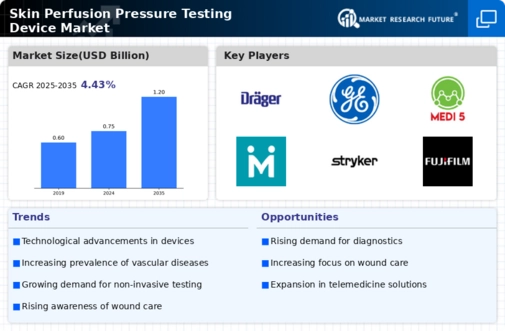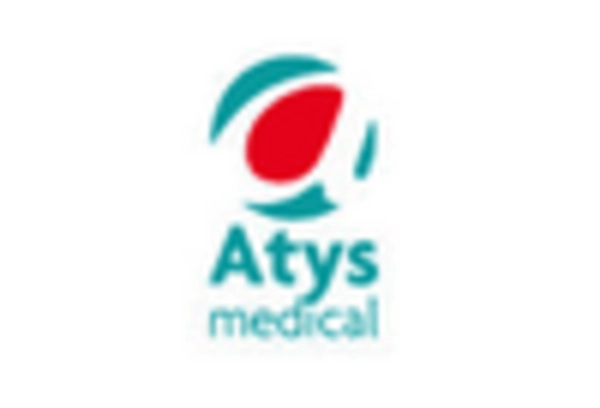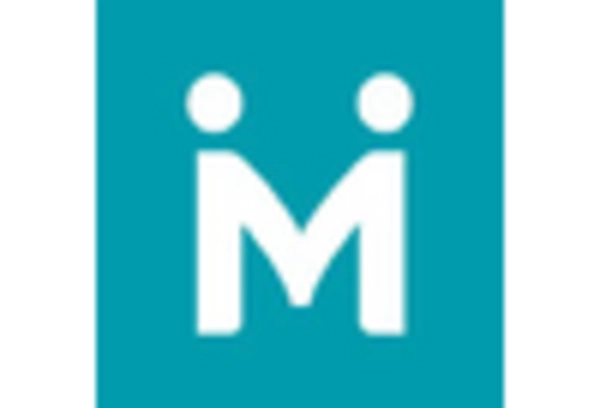Increase in Geriatric Population
The increase in the geriatric population is a notable factor propelling the Skin Perfusion Pressure Testing Device Market. As individuals age, they become more susceptible to various health issues, including chronic wounds and vascular diseases. The elderly population often experiences reduced blood flow and skin integrity, necessitating regular assessments of skin perfusion pressure. According to demographic studies, the proportion of individuals aged 65 and older is projected to rise significantly in the coming years, leading to a higher demand for effective diagnostic tools. Healthcare systems are increasingly focusing on tailored solutions for the elderly, which includes the adoption of skin perfusion pressure testing devices. This trend highlights the need for specialized care and monitoring in this demographic, thereby driving market growth.
Rising Incidence of Chronic Wounds
The increasing prevalence of chronic wounds, such as diabetic ulcers and pressure sores, drives the demand for the Skin Perfusion Pressure Testing Device Market. Chronic wounds affect millions of individuals, leading to significant healthcare costs and complications. According to recent estimates, chronic wounds affect approximately 6.5 million patients annually, creating a substantial need for effective diagnostic tools. The Skin Perfusion Pressure Testing Device plays a crucial role in assessing blood flow and tissue viability, which is essential for timely intervention. As healthcare providers seek to improve patient outcomes and reduce the burden of chronic wounds, the market for these devices is expected to expand. This trend indicates a growing recognition of the importance of early detection and management of chronic wounds, thereby enhancing the overall efficacy of treatment protocols.
Growing Awareness of Vascular Health
The rising awareness of vascular health and its impact on overall well-being is a significant driver for the Skin Perfusion Pressure Testing Device Market. As healthcare education emphasizes the importance of vascular assessments, more clinicians are recognizing the role of skin perfusion pressure testing in diagnosing and managing vascular conditions. This heightened awareness is leading to increased screening and monitoring of patients at risk for vascular diseases. Furthermore, educational initiatives and campaigns aimed at both healthcare providers and patients are fostering a culture of proactive health management. Consequently, the demand for skin perfusion pressure testing devices is expected to grow, as they are essential tools for evaluating vascular health and guiding treatment decisions.
Technological Innovations in Medical Devices
Technological advancements in medical devices significantly influence the Skin Perfusion Pressure Testing Device Market. Innovations such as portable devices, enhanced imaging techniques, and real-time monitoring capabilities are transforming the landscape of wound care. These advancements not only improve the accuracy of skin perfusion pressure measurements but also facilitate easier integration into clinical workflows. The market is witnessing a shift towards devices that offer user-friendly interfaces and connectivity features, allowing for better data management and analysis. As healthcare professionals increasingly adopt these advanced technologies, the demand for sophisticated skin perfusion pressure testing devices is likely to rise. This trend underscores the importance of continuous innovation in enhancing diagnostic capabilities and improving patient care.
Regulatory Support for Advanced Medical Technologies
Regulatory support for advanced medical technologies is a crucial driver for the Skin Perfusion Pressure Testing Device Market. Governments and regulatory bodies are increasingly recognizing the importance of innovative medical devices in improving patient care. Initiatives aimed at expediting the approval process for new technologies are encouraging manufacturers to invest in research and development. This supportive regulatory environment fosters innovation and enhances the availability of advanced skin perfusion pressure testing devices in the market. As a result, healthcare providers gain access to cutting-edge tools that can improve diagnostic accuracy and patient outcomes. The ongoing collaboration between regulatory agencies and the medical device industry is likely to further stimulate market growth, as it paves the way for the introduction of novel solutions that address unmet clinical needs.


















Leave a Comment